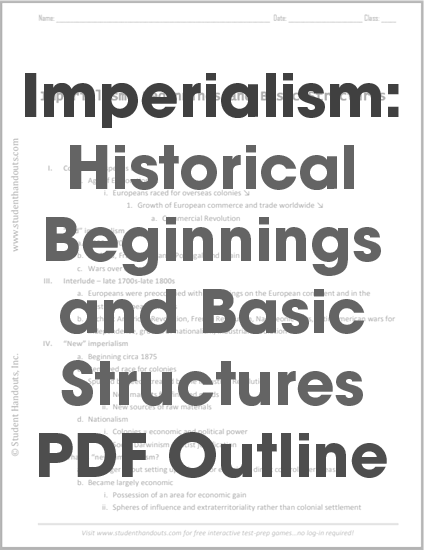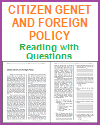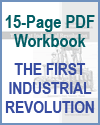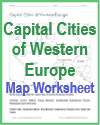| Imperialism: Historical Beginnings and Basic Structures Printable PDF Outline |
|---|
| www.studenthandouts.com ↣ World History ↣ Imperialism ↣ Imperialism Outlines & PPTs |
 I. Colonialism speeds up
I. Colonialism speeds upa. Age of Exploration i. Europeans raced for overseas colonies 1. Growth of European commerce and trade worldwide a. Commercial Revolution II. "Old" imperialism a. 1500s-1700s b. England, France, Holland, Portugal, and Spain c. Wars over colonies III. Interlude—late 1700s-late 1800s a. Europeans were preoccupied with happenings on the European continent and in the existing European colonies b. Such as: American Revolution, French Revolution, Napoleonic wars, Latin American wars for independence, growth of nationalism, Industrial Revolution IV. "New" imperialism a. Beginning circa 1875 b. Renewed race for colonies c. Spurred by needs created by the Industrial Revolution i. New markets for finished goods ii. New sources of raw materials d. Nationalism i. Colonies = economic and political power ii. Social Darwinism = racist justification V. What is "new" imperialism? a. No longer about setting up colonies or exercising direct control over areas b. Became largely economic i. Possession of an area for economic gain ii. Spheres of influence and extraterritoriality rather than colonial settlement VI. Economic motives a. Markets for finished goods i. Products of British Industrial Revolution sold in China and India b. Sources of raw materials i. Egypt—cotton ii. Malaya—rubber and tin iii. Middle East—oil c. Capital investments i. Profits from Industrial Revolution invested in mines, railroads, etc., in unindustrialized areas VII. Political motives a. Nationalism—national pride i. "The sun never sets on the British empire." b. Large empires increased national pride c. French acquisitions in Africa and Asia followed France's defeat in the Franco-Prussian War VIII. Military motives a. Bases i. British naval bases 1. Aden, Alexandria, Cyprus, Hong Kong, Singapore b. Manpower i. British—Indian sepoys ii. French—north African troops IX. Social motives a. Surplus population i. Japanese in Korea ii. Italians in Africa b. "White Man's Burden" i. Rudyard Kipling's poetry and prose ii. Whites morally obligated to bring the "blessings of civilization" to "backward" peoples iii. Cecil Rhodes—imperialism is "philanthropy—plus five percent" X. Religious motives a. Conversion to Christianity b. End-of-the-century crusading spirit c. Missionaries in Africa, Asia, Hawaii, etc. XI. Justifications a. Social Darwinism i. Interpreted Darwin's evolutionary theory in terms of powerful nations 1. "Only the strong survive" ii. Powerful nations able to develop areas and resources being "wasted" by native peoples b. Racism i. Increased feelings of white/European superiority 1. Also increased feelings of Japanese superiority in Asia ii. Eugenics developed as a branch of science XII. Concession imperialism a. Economic privileges and rights given for a specific purpose b. U.S. and British oil concessions throughout the Middle East c. Ottoman Turks granted Germany permission to build Berlin-to-Baghdad Railroad XIII. Sphere of influence imperialism a. Exclusive control over an area b. Examples i. British trading rights in Chin's Yangtze valley ii. French trading rights in southeastern China iii. Japanese trading rights in Korea XIV. Leasehold imperialism a. Lease over an area b. Suez Canal Corporation i. Suez Canal built by French in 1860s ii. Controlled by British shortly thereafter until 1968 c. Panama Canal i. United States d. Germans in Kiachow e. French in Kwangchow f. British in Weihaiwei XV. Protectorate imperialism a. Foreign control exercised through native "puppet" rulers b. French—Morocco (1906-1956) c. British—Egypt (1914-1968) i. Britain held a sphere of influence in Egypt from 1882-1914 ii. Britain gained control of Egypt as Egypt's protectorate when the Ottoman empire fell apart during World War I XVI. Annexation imperialism a. Territory annexed and turned into a colony under the complete control of a foreign power b. German colonies in east and southwest Africa—until 1918 & the end of World War I c. French Indochina (Vietnam)—until 1955 d. British Burma—until 1948 XVII. Mandate imperialism a. Victors of World War I gained control over German possessions under mandates granted by the League of Nations b. German East Africa → Great Britain c. Pacific islands north of the equator → Japan d. Syria → France XVIII. Trusteeship imperialism a. Victors of World War II gained control over Japanese and German colonies under trusteeships granted by the United Nations b. United States → Okinawa and Caroline Islands c. Italy → Somalia XIX. Review questions a. Describe three motives for imperialism. b.Describe three types of imperialism. c. Which nations became imperial powers? d. Which nations were controlled by imperial powers? e. How did imperial powers justify their control over foreign nations? Click here to print. For a PowerPoint version of this outline, click here. |
 |  |  |  |  |  |
| Imperialism Books and Films | Imperialism Outlines and PowerPoints |
| Imperialism Maps and Pictures | Imperialism Study Games |
| Imperialism Miscellany | Imperialism Worksheets |
| www.studenthandouts.com ↣ World History ↣ Imperialism ↣ Imperialism Outlines & PPTs |








